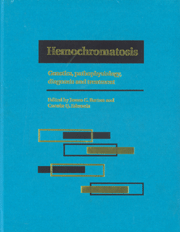Book contents
- Frontmatter
- Contents
- List of contributors
- Foreword
- Part I Introduction to hemochromatosis
- Part II Genetics of hemochromatosis
- Part III Metal absorption and metabolism in hemochromatosis
- Part IV Diagnostic techniques for iron overload
- Part V Complications of iron overload
- 21 Mechanisms of iron toxicity
- 22 Iron as a carcinogen
- 23 Clinical spectrum of hepatic disease in hemochromatosis
- 24 The arthropathy of hemochromatosis
- 25 Diabetes mellitus and hemochromatosis
- 26 Non-diabetic endocrinopathy in hemochromatosis
- 27 Cutaneous manifestations of hemochromatosis
- 28 Cardiac abnormalities in hemochromatosis
- 29 Estimate of the frequency of morbid complications of hemochromatosis
- 30 Juvenile hemochromatosis
- Part VI Therapy of hemochromatosis and iron overload
- Part VII Infections and immunity in hemochromatosis
- Part VIII Hemochromatosis heterozygotes
- Part IX Relationship of hemochromatosis to other disorders
- Part X Animal models of hemochromatosis and iron overload
- Part XI Screening for hemochromatosis
- Part XII Hemochromatosis: societal and ethical issues
- Part XIII Final issues
- Index
26 - Non-diabetic endocrinopathy in hemochromatosis
from Part V - Complications of iron overload
Published online by Cambridge University Press: 05 August 2011
- Frontmatter
- Contents
- List of contributors
- Foreword
- Part I Introduction to hemochromatosis
- Part II Genetics of hemochromatosis
- Part III Metal absorption and metabolism in hemochromatosis
- Part IV Diagnostic techniques for iron overload
- Part V Complications of iron overload
- 21 Mechanisms of iron toxicity
- 22 Iron as a carcinogen
- 23 Clinical spectrum of hepatic disease in hemochromatosis
- 24 The arthropathy of hemochromatosis
- 25 Diabetes mellitus and hemochromatosis
- 26 Non-diabetic endocrinopathy in hemochromatosis
- 27 Cutaneous manifestations of hemochromatosis
- 28 Cardiac abnormalities in hemochromatosis
- 29 Estimate of the frequency of morbid complications of hemochromatosis
- 30 Juvenile hemochromatosis
- Part VI Therapy of hemochromatosis and iron overload
- Part VII Infections and immunity in hemochromatosis
- Part VIII Hemochromatosis heterozygotes
- Part IX Relationship of hemochromatosis to other disorders
- Part X Animal models of hemochromatosis and iron overload
- Part XI Screening for hemochromatosis
- Part XII Hemochromatosis: societal and ethical issues
- Part XIII Final issues
- Index
Summary
Introduction
The earliest reports of hemochromatosis recognized involvement of the endocrine system in this condition; diabetes mellitus was the first recorded endocrine disorder. With wider recognition of hemochromatosis, involvement of other endocrine glands was suspected and early reports emphasized the occurrence of hypogonadism. Diagnosis at that time was based solely on clinical features, though in some instances was supported by histological data obtained at autopsy. In 1935, Sheldon described in detail the occurrence of sexual hypoplasia presenting as ‘loss of hair and impotence with atrophic testes and the body showing feminine characteristics.’ He suggested that this clinical syndrome was the most frequent manifestation of hemochromatosis, after the classical triad of diabetes mellitus, hepatomegaly, and pigmentation. Since then, other endocrinopathies have been reported in association with hemochromatosis, though none with the frequency of hypogonadism.
In the foregoing account, the non-diabetic endocrinopathies associated with hemochromatosis are discussed. There are profound differences in the relative frequency with which the various glands are affected. This may simply be a function of the severity and duration of iron deposition. However, one might question this hypothesis, bearing in mind the severity of iron deposition seen in certain glands, notably the thyroid and parathyroids, whose function seems rarely to be affected. However, there may be a variability in the vulnerability of different secretory cells to the toxic effects of iron. The reason for this is not apparent, nor is it clear why iron deposition should be more severe in some glands than in others. At present, methods for quantifying iron in endocrine cells is relatively imprecise, and improved methods may be informative.
- Type
- Chapter
- Information
- HemochromatosisGenetics, Pathophysiology, Diagnosis and Treatment, pp. 278 - 289Publisher: Cambridge University PressPrint publication year: 2000
- 10
- Cited by



